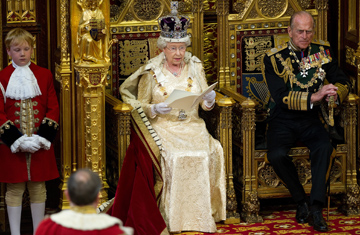
Ever since Guy Fawkes attempted to reform the British Parliament in his own unique fashion in 1605 — with a failed attempt to kill the Protestant King James I by blowing the place up — successive governments have talked about modernizing the country's constitution. Reform, along with tackling the massive government debt, was the focus yet again on Tuesday, when Britain's new Parliament sat for its first session. But the history, ceremony and tradition surrounding the recently elected government's first day in the House of Commons suggest that change may not come so easy.
The Conservative–Liberal Democrat coalition government put at the heart of its first legislative program a pledge to introduce "parliamentary and political reform to restore trust in democratic institutions and rebalance the relationship between the citizen and the state." Deputy Prime Minister Nick Clegg has gone so far as to suggest the government would offer the most wide-ranging reforms of British democracy for 200 years or more.
The proposals have been given urgency in the wake of a series of extraordinary revelations over the past few months about widespread abuses of the lavish expenses system enjoyed by MPs of all parties over the past few decades. Faced with mounting public anger and disengagement, each party is now committed to cleaning up British politics.
The expenses system has already been tightened to the extent that an MP almost can't buy a paper clip without getting a receipt. And now the government plans to introduce fixed, five-year Parliaments, to replace the current system in which a sitting Prime Minister can choose to call an election at any point within a five-year term that best suits his party or his chances of re-election.
Meanwhile, also in the planning are a referendum on abandoning the current first-past-the-post electoral system in favor of a form of proportional representation, and introducing elections to the legislature's second chamber, the House of Lords, which was once the domain of aristocrats who inherited their positions generation after generation. Whether these reforms will restore voters' trust in and respect for Parliament is yet to be seen, and the proceedings during the opening of Parliament on Tuesday suggest that reform is not as simple as it might appear.
For example, as dictated by one of the more bemusing rules of the British constitution, which does not exist in any single written document, it was Queen Elizabeth II who read aloud the words proposing the new government's reforms — along with an outline of the rest of the coalition's plans — while bedecked in robes and wearing the Imperial State Crown as she sat on her gilded throne in the ornate House of Lords. Prime Minister David Cameron and the opposition parties got to announce the program only in the Commons, launching a five-day debate on its contents, once the Queen had delivered her speech.
The elaborate and minutely choreographed proceedings of the state opening and the Queen's speech can appear quaintly anachronistic in Britain's modern democracy, but their historically rooted quirks continue to underpin the nation's political system. They offer clues to how British democracy has evolved, for good or ill — and perhaps why reform has been so slow up until now.
The rituals are often designed to remind members just why there is the constitutional separation between the monarch and the legislature. There is, for one, the taking hostage of a member of the government by Buckingham Palace. This purely ceremonial and symbolic act is to ensure that the Queen returns safely from a Commons that has, in past centuries, been hostile to the monarch's very presence. The hostage doesn't suffer the indignity of being thrown into a cell but is instead offered refreshments — a gin and tonic being the tradition — and the option of watching the proceedings in nearby Westminster Palace on TV. The Queen has, so far, always returned unharmed.
That same symbolic reassertion of the Commons' place in the constitution also explains why the Queen's representative, called the Gentleman Usher of the Black Rod, has the door of the Commons slammed in his face when he approaches it to urge MPs to walk the short distance to the Lords to hear the Queen deliver her speech. Only after banging loudly three times on the door, with a black rod no less, is he allowed entry. This ritual dates to 1642, when King Charles I entered the Commons and attempted to arrest five MPs. The Speaker of the Commons — its elected head — refused to comply, asserting the rights of MPs to resist the King, and ever since, no monarch has been allowed into the Commons, and even Black Rod needs permission to enter.
There are scores of similar small, symbolic actions that date back centuries, which previous governments have found are highly resistant to change. Perhaps the most obvious is the previous Labour government's attempt to reform the House of Lords, which was started in 1999 by then Prime Minister Tony Blair and stalled after MPs could not decide what proportion, if any, of the House should be elected.
It's no surprise that the current Parliament has returned to the idea of tackling the House of Lords issue, this time by adding the element of elections. As the Queen said on Tuesday, reading the government's words: "Proposals will be brought forward for a reformed second House that is wholly or mainly elected on the basis of proportional representation." She has, of course, said much the same several times before. It remains to be seen whether, this time, change will come.
